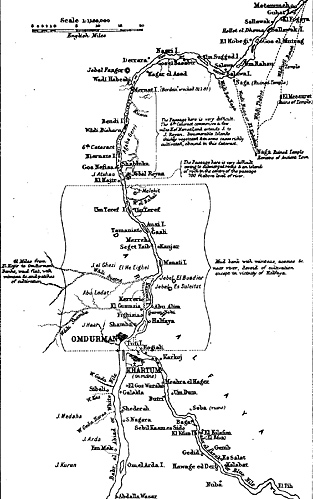 Over the years I have read quite a few accounts of the Gordon Relief Expedition of 1884-85. The final, failed attempt to reach Khartoum by Nile steamers usually receives short shrift, often with veiled or open criticism of the acting commander, General Sir Charles Wilson.
Over the years I have read quite a few accounts of the Gordon Relief Expedition of 1884-85. The final, failed attempt to reach Khartoum by Nile steamers usually receives short shrift, often with veiled or open criticism of the acting commander, General Sir Charles Wilson.
Jumbo Map (very slow: 387K).
More recently I have had the good fortune to read Wilson’s own account of the expedition, “From Korti to Khartoum’, written shortly after the events took place.. Even allowing for personal bias it is an amazing story, and gives a fair appreciation for the difficulties faced and the heroic efforts made by the men on the spot.
It is also, and more pertinently, rich ground for the gamer.
I will not dwell too much here on the Desert column’s crossing of the Nile “Loop” to Metemmah, or events prior to Wilson’s departure down the Nile towards Khartoum. These are more widely known and the bibliography gives some references for further reading. Suffice to say that precious days were lost before departure and this is where Wilson comes in for much criticism. Wilson’s own account outlines his decision to scout the Nile in both directions and to try to gain some intelligence of enemy forces and intentions. By this stage the Desert Column was deep in enemy territory, having sustained heavy casualties and with many wounded, with it’s commander mortally wounded and incapacitated and with a tenuous supply line dependant on a rapidly dwindling number of camels.
Given the circumstances it is perhaps remarkable that an attempt to relieve on Khartoum was made at all.
Four steamers had been sent to meet the relief column by Gordon. They linked up with the British force at Metemmah, and in consultation with the sole surviving naval Officer (Beresford), Wilson decided to take the two largest and best protected boats, “Talahawiyeh” and “Bordein” in the dash to Khartoum.
The boat captains advised him that in twelve days they would not be able to pass the cataracts due to the falling level of the Nile. Omdurman, across the Nile from Khartoum, was known to be held by the enemy, and there were several batteries along the river they would have to fight past while attempting to get upstream. Prudent precautions for overhauling the engines, selecting crews, loading supplies and strengthening defenses took up valuable time.
- “The original plan was for Beresford to man two of the steamers with the naval Brigade, mount his Gardiner gun on one of them, and after overhauling them, take me to Khartoum with about fifty men of the Sussex Regiment. This was now impossible; all of the naval officers were killed or wounded except Beresford, who was himself unable to walk, and many of the best petty officers and seaman were also gone.”
--Wilson
Wilson allowed for the possibility that the remaining steamers might have to fight, and so left Beresford with them. Given the situation of the desert column, Wilson “did not feel justified in taking more than an officer and twenty men as an escort.” Wolseley had sent red coats specifically to be worn by the troops entering Khartoum, but these had been lost or looted. Enough were raised from the Guards and Heavies to equip the small Sussex contingent.
- “We were going to fight our way up the river and into Khartoum in two steamers of the size of ‘”penny” steamers on the Thames, which a single well-directed shell would send to the bottom: with crews and soldiers absolutely without discipline; with no surgeon; and with only one interpreter, the faithful Muhammed Ibrahim, still suffering from a flesh-wound in the side.”
Wilson
Stewart's Dash to Khartoum The Final Attempt to Relieve General Gordon
Part II
Stewart's Dash to Khartoum The Final Attempt to Relieve General Gordon Part II
- January 28
January 29
January 30-31
February 1-3
February 4 and Bibliography
Orders of Battle
Gaming the Action
Models, Terrain, and Tactics
Back to The Heliograph # 139 Table of Contents
Back to The Heliograph List of Issues
Back to Master Magazine List
© Copyright 2003 by Richard Brooks.
This article appears in MagWeb.com (Magazine Web) on the Internet World Wide Web.
Other articles from military history and related magazines are available at http://www.magweb.com